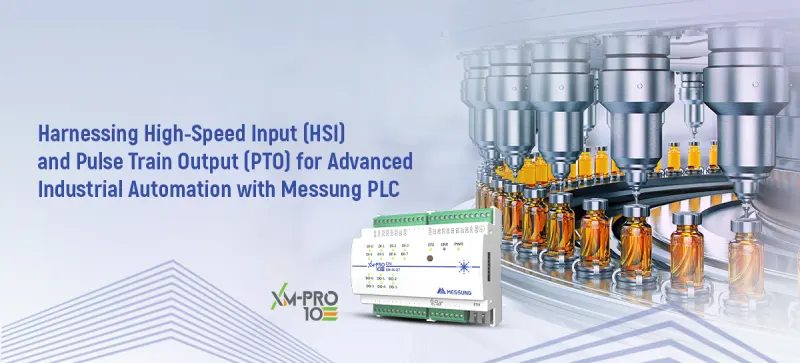
In the world of industrial automation, precision and control are non-negotiable. Whether it’s monitoring conveyor belts, controlling servo motors, or ensuring exact cut lengths in manufacturing processes, the importance of reliable signal processing and motor control cannot be overstated.
High-Speed Input (HSI) and Pulse Train Output (PTO) are advanced features found in modern PLCs, including those from Messung, that revolutionize automation by offering unmatched accuracy and functionality.
Understanding High-Speed Input (HSI)
HSI is a specialized feature designed to handle fast input signals that traditional input modules may struggle to process. It enables real-time counting and precise signal detection from high-speed sensors or encoders, making it a cornerstone of advanced automation solutions.
Key Characteristics of HSI:
- Fast Signal Detection: Handles high-frequency inputs with ease, ensuring seamless operation with high-resolution encoders and sensors, such as Eye Mark sensors for product detection.
- Versatile Applications: Suitable for tasks like object counting on conveyor belts, rotational speed monitoring, and length measurement using encoder feedback.
Example Use Case:
Cut-to-Length (CTL) Machinery
In cut-to-length applications, HSI plays a pivotal role by ensuring precision. For example, an encoder counts pulses to measure the material length. Once the set pulse count is reached, the PLC commands the motor to stop, resulting in exact cuts. This system is ideal for processing materials like metal, paper, plastic sheets, or pipes, significantly improving productivity and accuracy.
What is Pulse Train Output (PTO)?
PTO, on the other hand, generates pulse signals with adjustable frequency, enabling precise control of stepper motors or servo drives. This feature is vital for applications requiring detailed movement control, such as positioning and speed regulation in automated systems.
Key Characteristics of PTO:
- Precision Control: Ensures smooth and accurate motor movement by modifying pulse counts. Feedback from encoders can also close the loop for enhanced control.
- Flexible Output Settings: Adjustable frequency and speed settings allow for creating trapezoidal speed profiles, making PTO suitable for diverse applications.
Example Use Case:
Vertical Form Fill Seal (VFFS) Systems
In VFFS systems, PTO controls a puller servo motor that adjusts based on the packet length set via an HMI interface. Additionally, a High-Speed Input (HSI) detects an I-mark on the web material, which the PLC uses to stop the motor at the precise moment. Advanced logic in the PLC can even include offsets to achieve perfect positioning for each cycle.
Industrial Applications of HSI and PTO
- Conveyor-Based Monitoring with HSI
High-speed sensors along a conveyor belt send signals to the HSI module, which counts items in real time. This setup is crucial for ensuring product accuracy, detecting missing or faulty items, and optimizing overall efficiency.
- Servo/Stepper Motor Control with PTO
PTO generates precise pulse signals to control servo or stepper motors, enabling accurate positioning in pick-and-place systems, robotic arms, and automated inspection setups.
- Sequential Automation in Production Lines
The combination of HSI for high-speed sensing and PTO for motor control facilitates synchronized operations in multi-step production processes. This setup ensures consistent, repeatable results, enhancing productivity and reliability.
Benefits of Using HSI and PTO in Automation
- Enhanced Precision: HSI and PTO ensure accurate timing and positioning, reducing errors and improving product quality.
- Efficient Process Control: Real-time data processing and precise motor control streamline workflows, boosting overall productivity.
- Scalability: These features are easily adaptable for complex, multi-axis systems, making them suitable for diverse industrial applications.
Challenges and Solutions
- Challenge 1: Integrating HSI and PTO with Legacy Systems
- Solution: Messung PLCs offer built-in support for HSI and PTO or provide seamless module integration with older systems.
- Challenge 2: Managing Signal Interference in High-Speed Applications
- Solution: Use proper shielding and signal conditioning techniques to maintain signal integrity and minimize disruptions.
The Future of HSI and PTO in Automation
As industrial automation evolves, the role of HSI and PTO continues to expand. These features are becoming increasingly integrated with IoT and smart factory solutions, enabling advanced data collection, real-time decision-making, and predictive maintenance. The incorporation of edge computing promises to further enhance processing speed and reduce latency, paving the way for smarter, more responsive automation systems.
High-Speed Input (HSI) and Pulse Train Output (PTO) are transformative tools in the industrial automation landscape. By enabling precise, real-time control and monitoring, they drive efficiency, accuracy, and scalability in production processes. Messung PLCs, with their robust support for HSI and PTO, empower industries to stay competitive in a fast-changing market.
By leveraging these technologies, facilities can achieve superior operational performance and build a foundation for future growth in the era of Industry 4.0.
